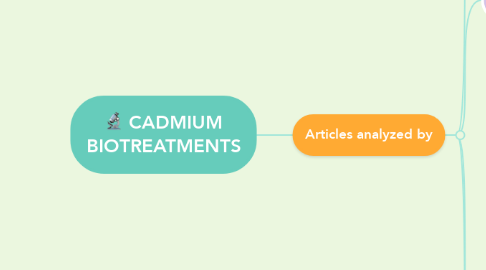
1. Articles analyzed by
1.1. Eduar
1.1.1. Cadmium accumulation and growth response to cadmium stress of eighteen plant species
1.1.1.1. Cadmium affects plant growth in a dose-dependent manner, all 18 plant species lagged greatly in growth, with Cadmium concentrations in sand increasing, root and shoot biomass and AGR achieved significantly.
1.1.2. Bacterial community response to cadmium contamination of agricultural paddy soil.
1.1.2.1. Bacterial communities associated with specific degrees of Cadmium concentration could be separated from these soil samples, and soil microbial communities clustered strongly according to degree of Cadmium concentration.
1.1.3. Sunlight mediated cadmium release from colored microplastics containing cadmium pigment in aqueous phase.
1.1.3.1. Under dark conditions, little Cadmium release was found for micro plastics with size 2.00 to 3.50mm, under simulated sunlight, micro plastics with size 2.00 to 3.50mm still have little Cadmium release.
1.1.4. Cadmium (II) removal mechanisms in microbial electrolysis cells
1.1.4.1. Cadmium removal was achieved rapidly since most of it disappeared in the first two days of treatment, the magnitude of the current did not have a direct effect on the rate of cadmium removal, since most of it was removed in the first days.
1.1.5. Improving cadmium resistance in Escherichia coli through continuous genome evolution
1.1.5.1. To obtain a highly resistant strain to cadmium, the GREACE method was used, the negative control strains could not grow on the plates containing cadmium, this indicated that the mutator of the plasmid accelerated the evolution of the genome in E. coli, therefore, mutants with increased resistance to cadmium could be obtained by screening the plates.
1.2. Sandra
1.2.1. Cadmium (heavy metals) bioremediation by Pseudomonas aeruginosa: a minireview
1.2.1.1. The best characterized bacterial resistance to Cd was identified in gram-positive bacteria. The presence of the czcA gene responsible for resistance to cadmium.
1.2.2. Performance evaluation of agro-based adsorbents for the removal of cadmium from wastewater
1.2.2.1. The highest removal efficiency of Cd(II) is 83.7% at pH 6.5 for coconut shell activated carbon.
1.2.3. Cadmium toxicity and treatment: An update
1.2.3.1. They have shown that antioxidants such as vitamin C and vitamin E have a protective effect against cadmium-induced toxicity.
1.2.4. Bioaccumulation of cadmium in soil organisms – With focus on wood ash application
1.2.4.1. 75% of the total deposit was inorganic Cd at pH 3. That fraction had decreased to 35% at pH 6. At pH 8, free Cd++ and inorganic Cd had increased to approximately 55%. The main metal storage organ for arthropods and molluscs is the hepatopancreas.
1.2.5. Bioremediation of cadmium- and zinc-contaminated soil using Rhodobacter sphaeroides
1.2.5.1. After bioremediation, the exchangeable phases of Cd and Zn in the soil were reduced by up to 30.7% and 100.0%, respectively; Cd levels in wheat leaf and root were reduced by up to 62.3% and 47.2%, respectively
1.3. Mayerli
1.3.1. Nanofloral clusters of carbon nanotubes on alumina are the best carbon-based nanomaterial for removing cadmium ions from water at pH 7.5.
1.3.2. Through the use of the electrocoagulation reactor, a 100% removal of cadmium present in industrial wastewater will be perfected in just 5 min, with low energy consumption, being a profitable treatment for the removal of heavy metals.
1.3.3. It is identified that the strain of Enterobacter sp. FM-1 inoculated in soils contaminated with cadmium promoted the growth of Centella Asiatica L, achieving a decrease in toxicity in the soil and the accumulation of cadmium in stems, leaves and roots of plants.
1.3.4. the experimental results that were compared were that the production of SCFA was improved by Cd at relevant environmental levels, but a high level of Cd inhibited the production of SCFA, in addition to the impact of Cd on the production of short-chain fatty acids (SCFA) a a from anaerobic sludge fermentation is dose dependent.
1.3.5. The stabilization of cadmium is achieved through the use of autochthonous bacteria after 166 days of biotreatment, obtaining a reduction in the concentration of cd by 77.6% and 96.4%.
1.4. Paola
1.4.1. The contribution of cadmium to the soil through the use of fertilizers is an environmental problem that not only affects the environment, but also human health. Crop uptake of the metal then passes to humans through bioaccumulation through the food chain. Due to these consequences, solution measures have been created, among which bioremediation is identified as a natural methodology that uses the use of bacteria and plants for soil remediation. In the articles it is possible to identify the use of the bacterium Bacillus Cereus M4, and plants such as: turnip, napus, pilosa, as a viable alternative for phytoremediation. In addition, the use of carbon-based nanomaterials is recommended for the treatment of cadmium-contaminated water. The use of fertilizer with a lower amount of phosphate is recommended.
